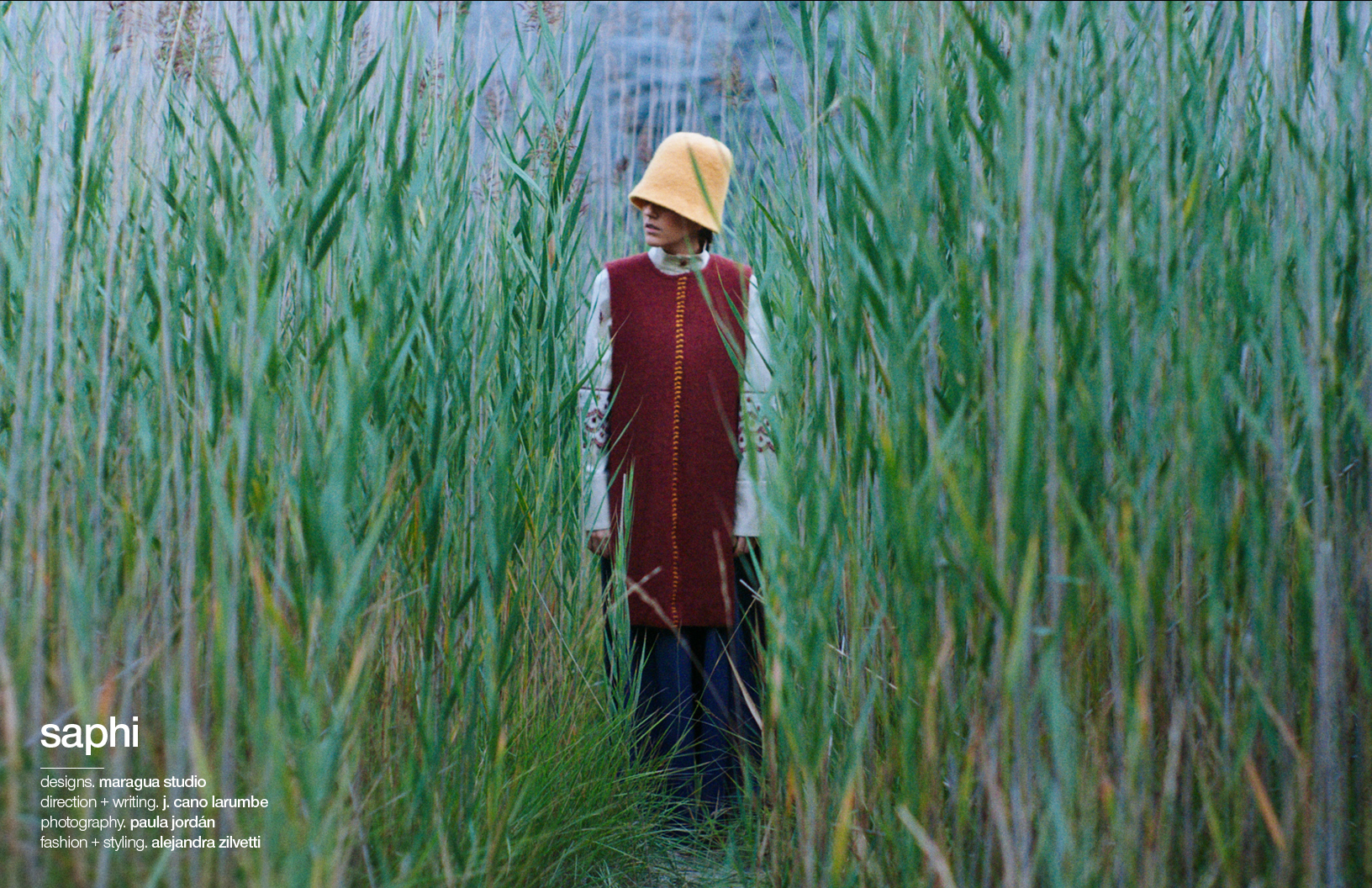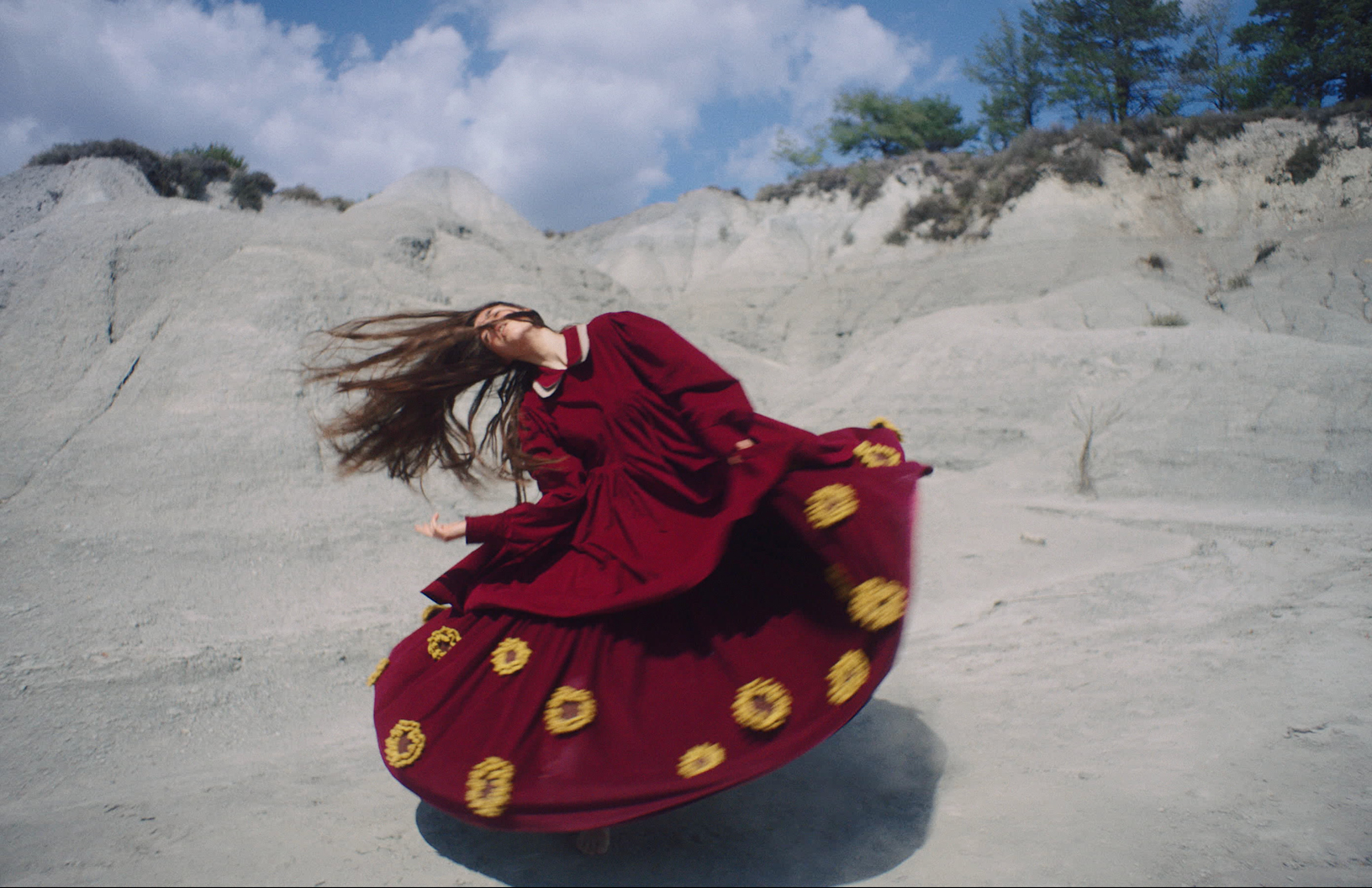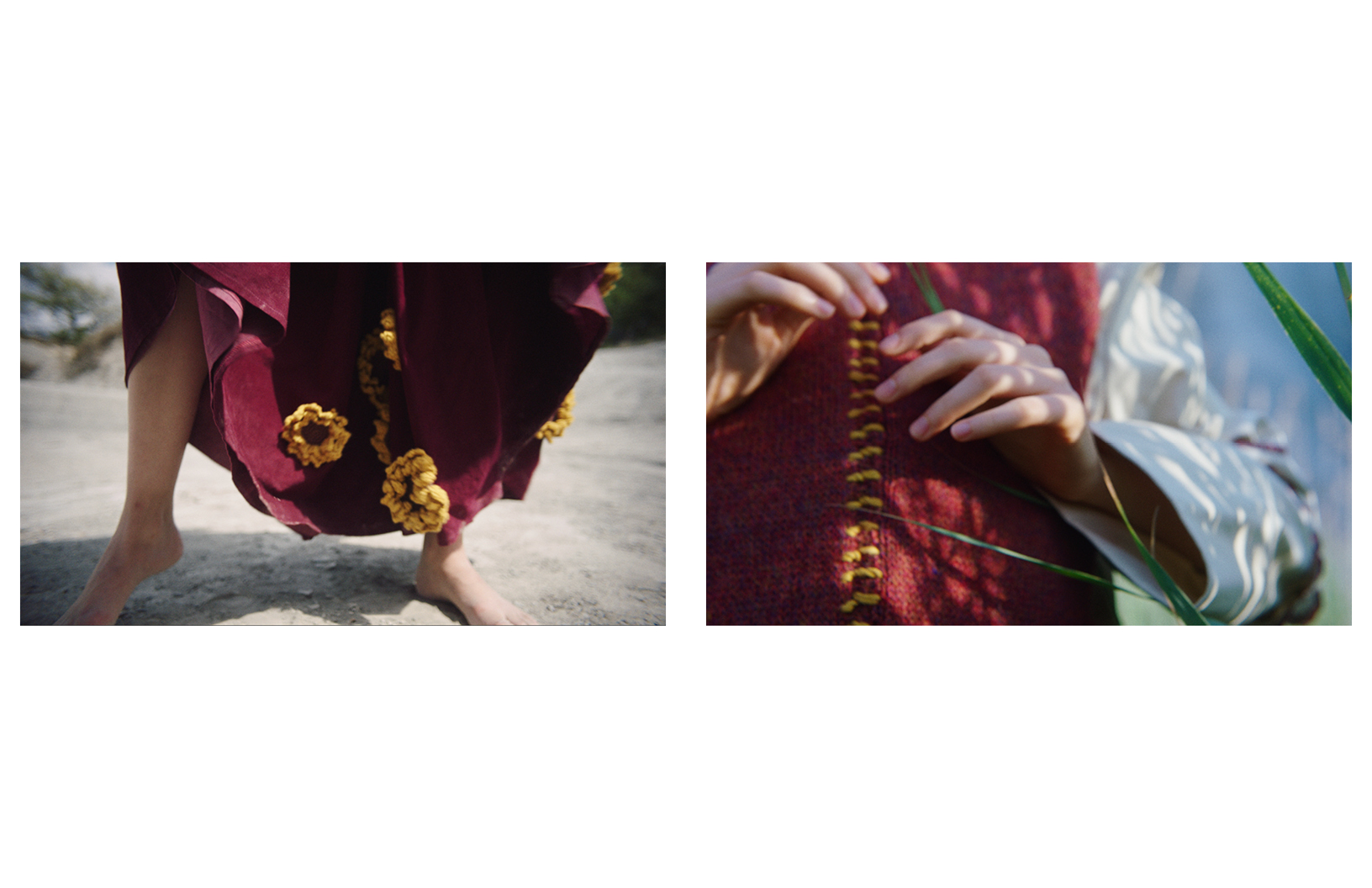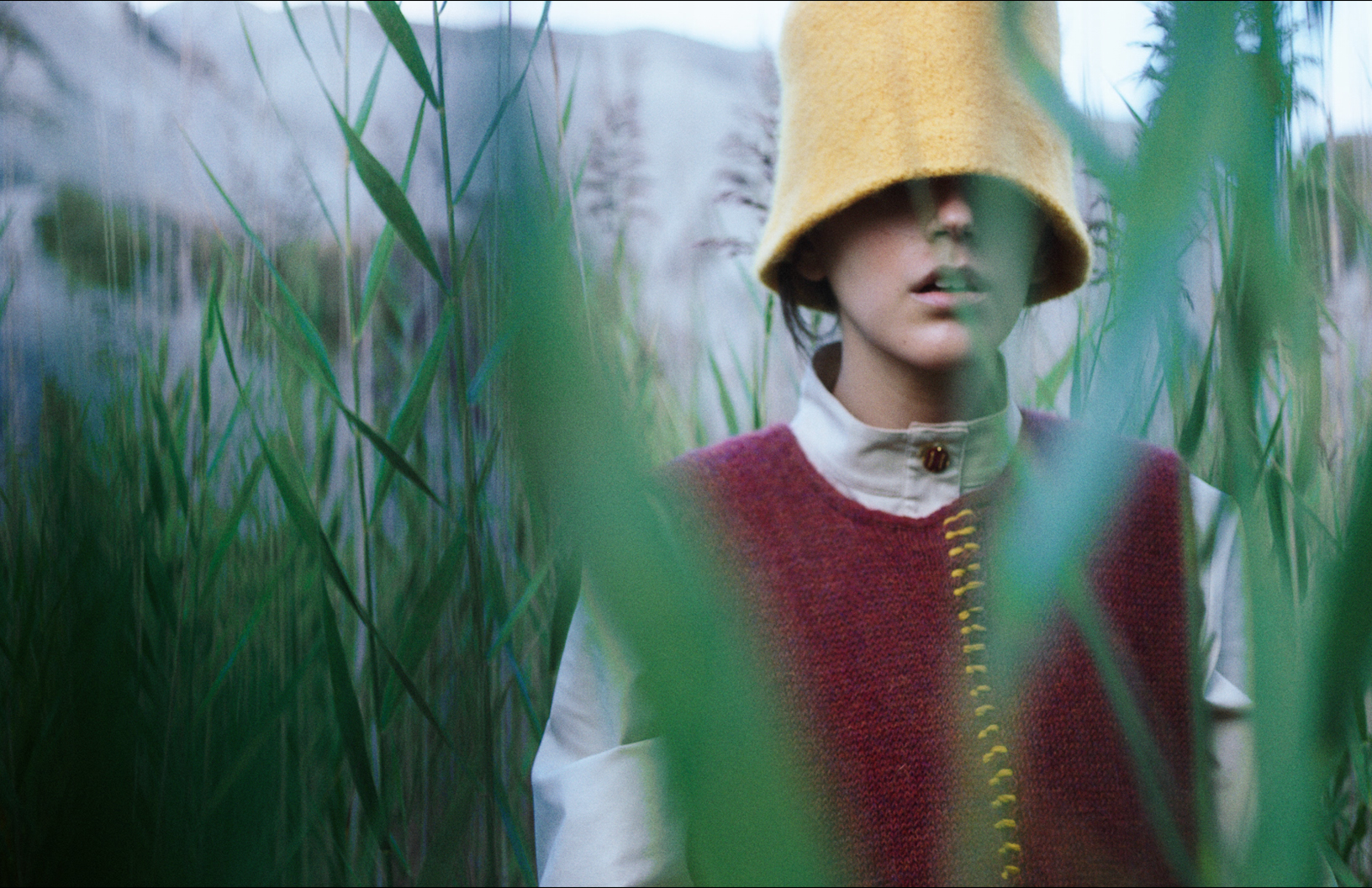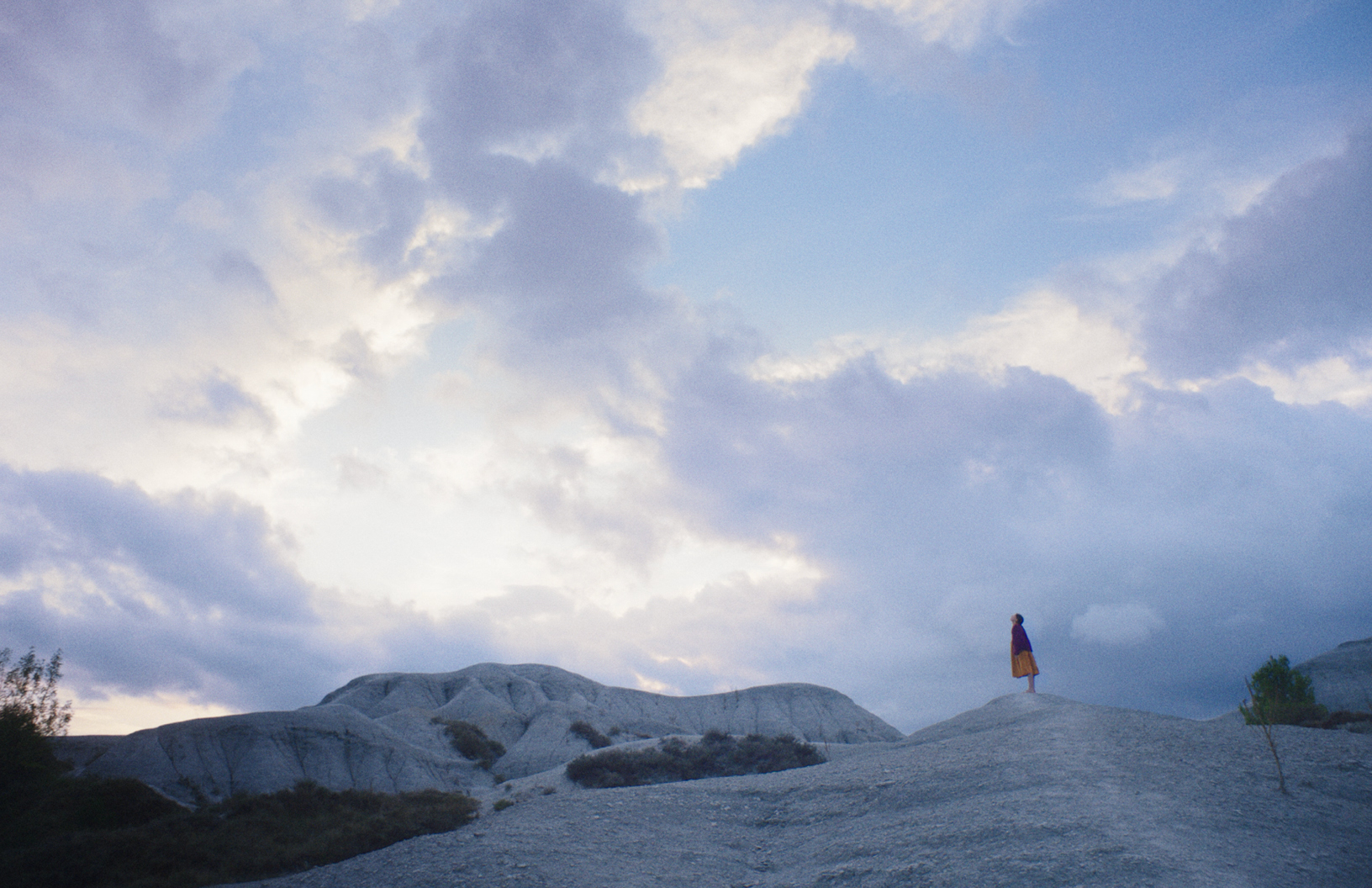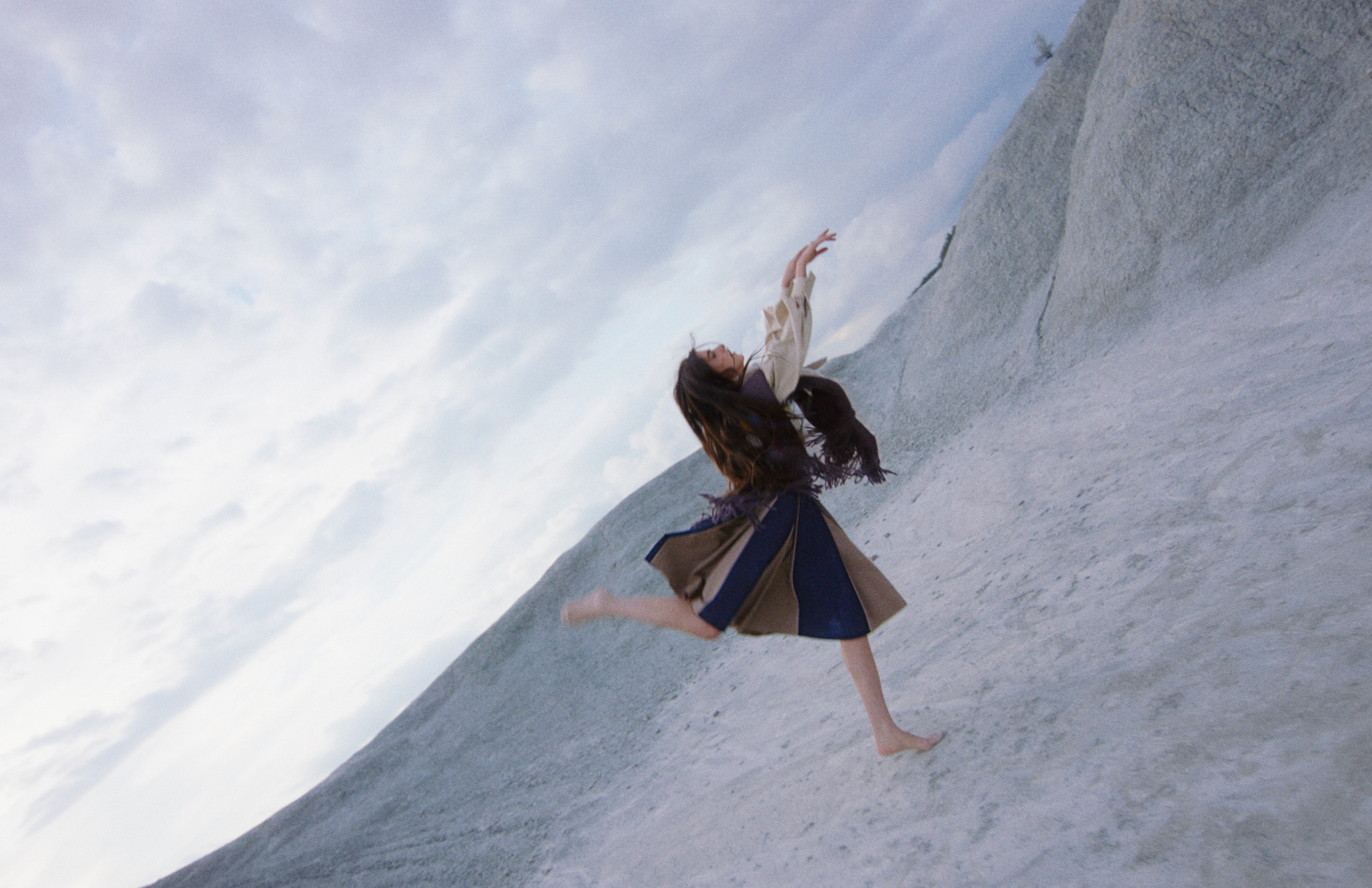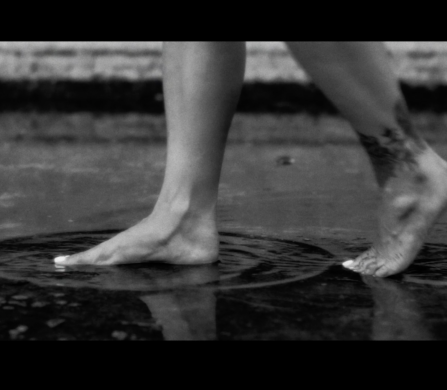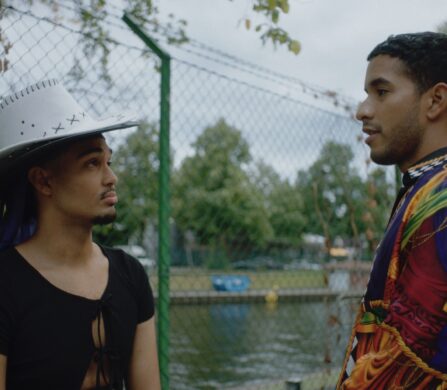Our roots are our origin story. They shape how we navigate the world, how we approach each situation, and how we relate to one another. It’s this desire to return to their origin stories that brought stylist Alejandra Zilvetti and director J. Cano Larumbe @ VIMEO to create “Saphi,” a fashion film. Weaving Maragua Studio‘s designs through the visuals, the film is the embodiment of adventure; a lesson in acceptance and coming to terms with who you are.
Zilvetti and Larumbe come together to showcase many stages of acceptance — fear, fights, letting go, and liberation — and do so by using the Spanish landscape to highlight different points of dancer Paula’s journey emotionally, mentally, and physically. These aspects are all visually shaped by Maragua Studio‘s clothing, using garments like ponchos and flowing skirts to demonstrate Paula own liberating journey as she unravels, breaks free, and finds her roots in the process.
To discuss the creation of the “Saphi” film, stylist Alejandra Zilvetti and director J. Cano Larumbe chat with Schön! Magazine about integrating Maragua Studio’s ethos into the film, crafting the storyboard and visual inspiration, showing one’s origin story, and more.
What is the initial concept behind the film? How did you create the storyboard?
CANO: “Saphi” is a Quechua word which means roots and origin. This project transmits the magnitude of connecting with ourselves and to get back to our origin. The purpose is to show the bond with nature and a vision of free femininity through the idea of dance. To transmit our idea, we structured the film in different phases, mixing locations, costumes and dance to pursue the feeling of being freer and more fluid as soon as we connect to the environment by being part of the same element.
I usually work with very detailed storyboards for my projects. However, on this particular project, I felt we needed to work more freely so that it felt more natural. It is for this reason that we set out to shoot without a closed storyboard. What we did was propose together with Paula, the cinematographer, a whole “image system” of how we wanted to shoot each of the situations and the evolution of the character. We thought about general camera concepts or types of shots, light, lenses… for each of the different moments, always thinking of having space to improvise during filming, looking for the connection between the dancer and the camera to be real.
What we worked on the most, together with Laura Castells and Paula Losada, was the narrative within the choreography. Considering that what we wanted to tell, and the journey that the character makes, was reflected through the dance. This was always our base and reference point while we were shooting.
What is the Maragua Studio brand’s mission or ethos throughout every project?
ALEJANDRA: The spirit of the brand is to recover something as valuable as crafts, that is our starting point. “Fast fashion” appeared years ago and with it a massive production of garments that you hate in your closet after a few months and you need to buy the latest novelty that you will also hate over time. All those clothes are soulless garments without that special factor that makes them unique.
That is why Maragua was born. I consider myself a lover of vintage stores and it was increasingly difficult for me to find a garment that would generate the same illusion as when I find a relic in a second-hand store. That is why at Maragua we want to create unique and special designs, like those garments that you find in your parents’ closet, which belonged to your grandparents and from the first moment they cease to be simple garments, they become a treasure.
We started creating made-to-order garments, my mother knitted all the garments one by one, making each garment have its essence. Now we are very excited because we are going to start collaborating with associations from different countries where they work the craft of crochet and knitting with the natural fibres that they work with. The truth is that we are very excited!
Are there specific artists or visualizers that have influenced your work overall or the “Saphi” film?
CANO: In all my works, I like to work on the style and the narrative depending on each piece and what we seek to convey. I consider myself a very narrative director and I always start with a narrative and visual language to start creating concepts or ideas. I suppose this is because I come from the world of fiction and my influence has always been cinema and movies. Specifically, the Steven Spielberg cinema that I discovered as a child was the one that opened my eyes to this wonderful world.
I always like to work between reality and fantasy, how the natural world becomes extraordinary, and I think “Saphi” is no exception. One of the things I like the most about the film is this more poetic point of view, close to fantasy, in which nature comes to life to communicate with our protagonist. For “Saphi,” the poetic and sensory imagery that we see in Terrence Malick’s films was also very present, and one of the main references was the video dances of director Neels Castillon.
“Saphi” is described as a “vision of free femininity.” What does “free femininity” mean to you?
CANO: “Saphi” is a journey towards our essence and our origins. Somehow, for us, in this more natural world, there are no differences, and everything is more pure and free. A place where we are ourselves, where everything is governed by the natural order of things, without impositions or concepts poorly established by humanity.
We start with the image of a woman who is closed in on herself, rigid and trapped. It ends with a woman who can move freely through space with force, someone who has discovered her place in this natural order. Because, after all, every part of us is a part of nature. To do this, the film is divided into different emotional stages throughout the different scenes: fear, inner fights, letting things go and liberation.
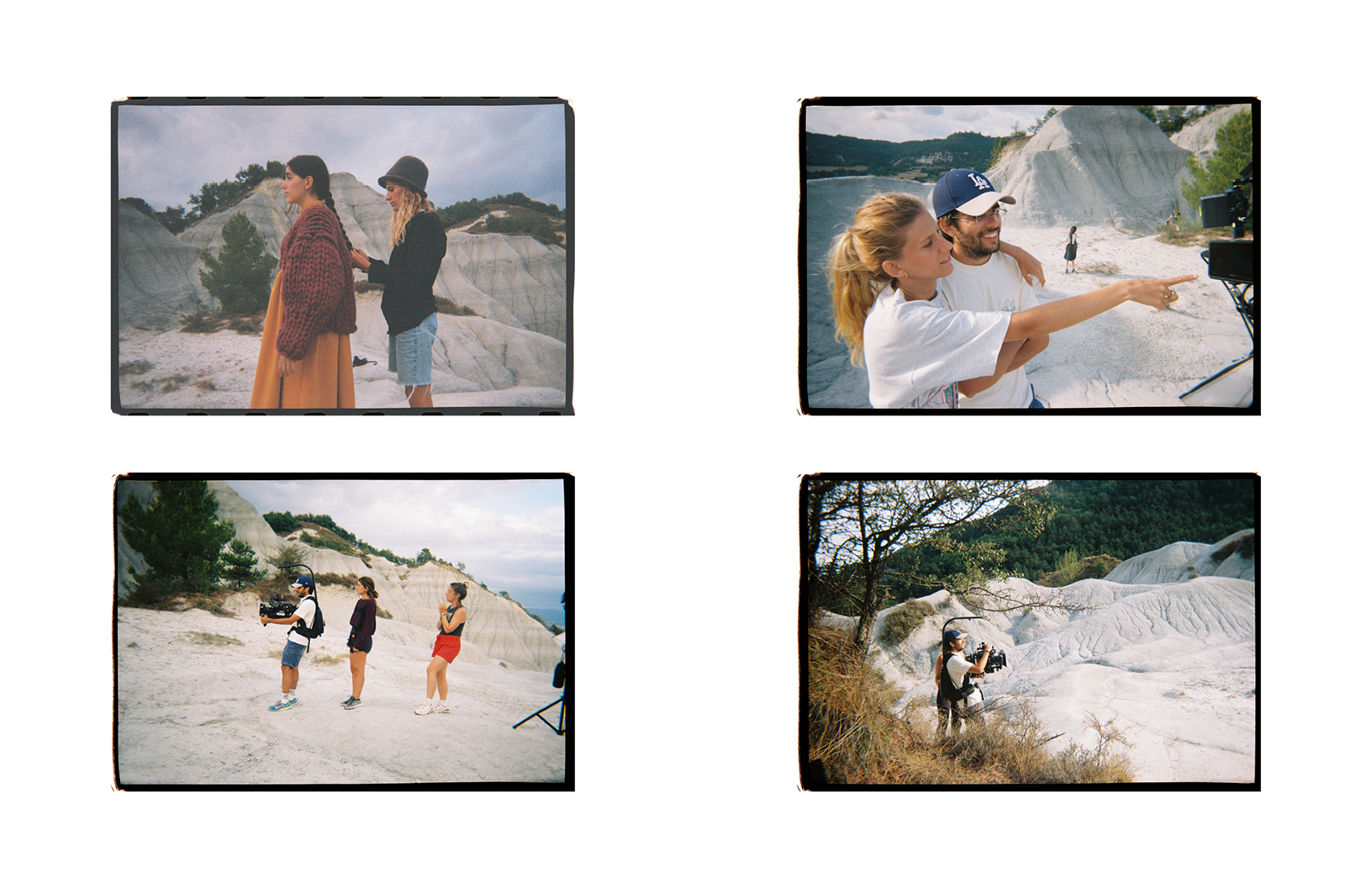
Nature is a focal point throughout the film and how fashion embraces its natural aspects. Why was this important for you to incorporate as such a major focal point in the film?
CANO: When speaking with Alejandra from the beginning, we were very clear that the presence of nature had to be the central point from which to build and pivot the film. We had to transmit her values as a designer and those of Maragua as a brand. In this sense, harmony with the environment was the most important thing. The truth is that everything was always in the same direction in a very organic and natural way.
ALEJANDRA: The name of Maragua comes from a small town in Bolivia that is in the heart of a volcanic crater at 3,104m above sea level. We were greatly inspired by nature and the colours that surround it, that is why it needed to be reflected in the fashion film. Although Maragua, nowadays, does not sell the garments that appear in the fashion film, we wanted to use it as a letter of introduction to our universe and present the values of the brand.
This film is about one’s ‘origin’ and connects us back to our own origin story to find ourselves and begin to feel comfortable and free. How did this concept influence the styling choices and costume design decisions that you made when selecting certain pieces?
ALEJANDRA: The looks were decided by each of the stages that Cano mentioned above. From the first moment, we were very clear about the arc of the character in each stage. “Saphi” was born from a collection that was my final project for my university degree. The collection is inspired by Bolivia since part of my family is from there. I wanted to recover that side that I had forgotten for a few years and reconnect with my roots.
The collection, like the fashion film, is a process of acceptance and peace of mind with oneself. The first stage is fear. For this stage, we chose garments with a straighter line, more structured to reflect that fear and the lack of movement. The second stage is the inner fights. In this stage, the garments begin to have a little more movement, they begin to have a little more flight, such as the maroon dress, but it is made with a fabric that is not light, it is heavy.
The next stage is letting go, where we see Paula, the dancer, with the short skirt and the poncho. These garments already fly by themselves with each movement, without ties and free. Finally, the liberation. This is where we find the last look, which is the one that can most remind us of the traditional Bolivian costumes, of the “cholitas,” is a moment where you have already found yourself and you are at peace with your roots. The textures are comfortable and pleasant.
Was there a specific aspect of the film that you found difficult to convey or film? On the flip side, was there one that was obvious to incorporate?
CANO: The answer to these questions is exactly the two opposite sides of the same coin. I found it very interesting that the protagonist’s emotional journey and her way of communicating with the audience were through dance. It seems to me, like music, a very pure and natural form of expression. Something intrinsic in each one of us, a language without barriers and universal, with which we manage to disconnect our most mental part, which sometimes fills our heads with noise, to give way to transmit and express ourselves with our emotions.
However, on the other hand, it was the first time I had filmed a dance film and I had to learn and let myself be always carried away by my intuition. I enjoyed it a lot.
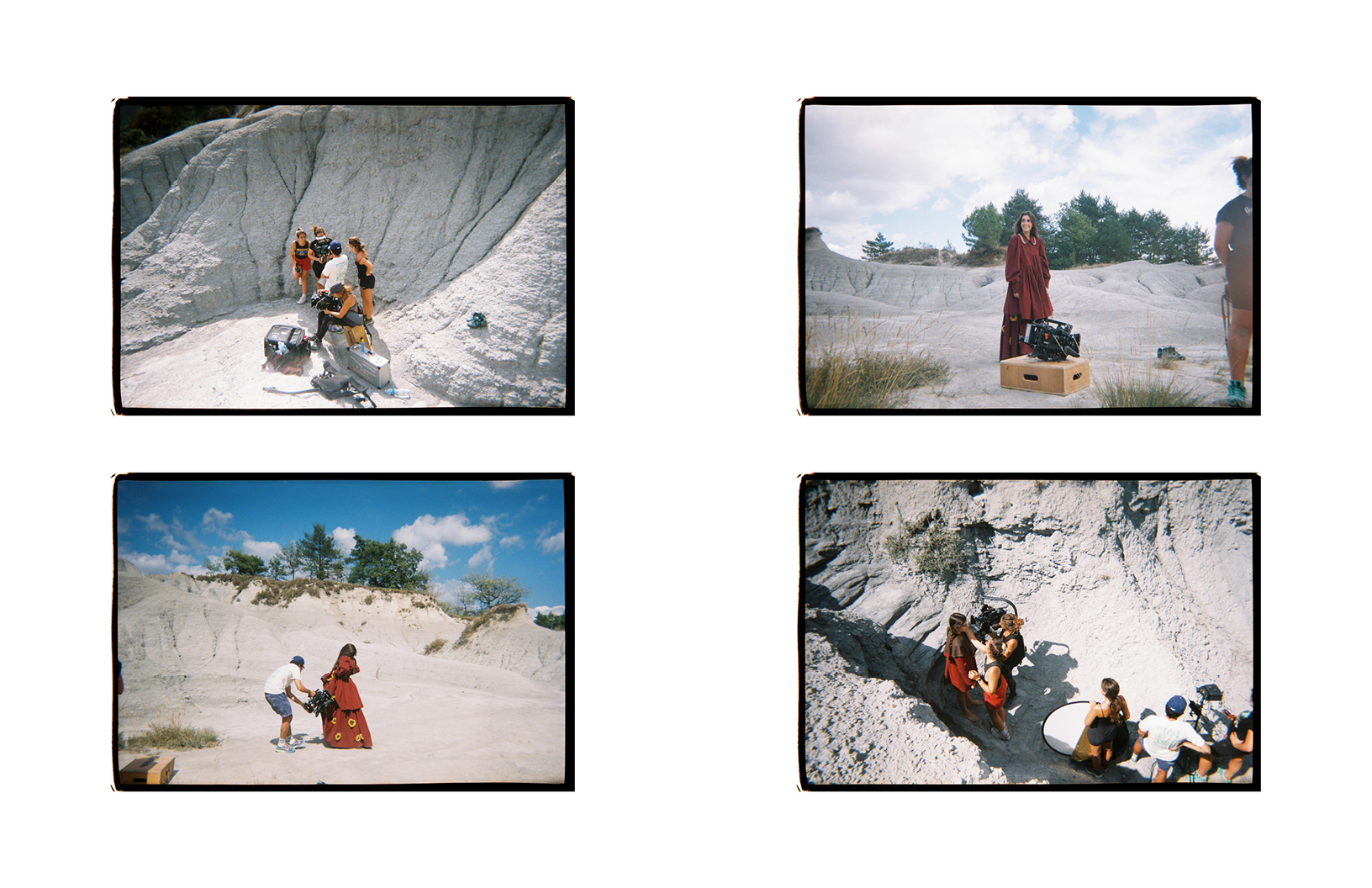
It was filmed in Spain — how did the natural patterns and juxtaposing spaces influence your filming decisions? How did they influence your styling choices?
CANO: The locations were always a key element for this piece. We knew that it was important both for the narrative of the film and also when it came to framing each of the looks that we were going to show. Each location helps to transmit the emotional moment in which the character is and reflects how our protagonist feels. In addition, we seek to highlight each of the looks either by playing with the textures, the fabrics or with the chromatic contrasts in each of the different situations.
Each look transmits a specific idea or emotion, and the same was sought to be transmitted through the locations. In this sense, Spain is an incredible place to shoot thanks to its great variety of landscapes, often within a very short distance from each other. At the production level, this helped us a lot since we had to shoot everything on the same day, in a location that provided us with a great variety of spaces and contrasts, trying to capture the beauty of the different moments of natural light.
As Maragua Studio commits to craftsmanship and sustainability, how do viewers see this in the film?
ALEJANDRA: Each look has artisan details and for me this is essential. The most obvious could be the maroon dress with all the crocheted flowers, the brown poncho with the embroidery, or even in the first look, the long-knitted vest with the zig-zag embroidery. All these details can only be achieved if they are made one by one by hand.
Lastly, what do you hope those feel after watching the film?
The sensation that we would like to remain in the viewer is the peace of mind that remains after a job well done. Feeling fulfilled and complete. Somehow, we want people to empathize with the protagonist and go through the different emotional states with her so that at the end of the film they also feel this peace and calm that comes after a heavy storm.
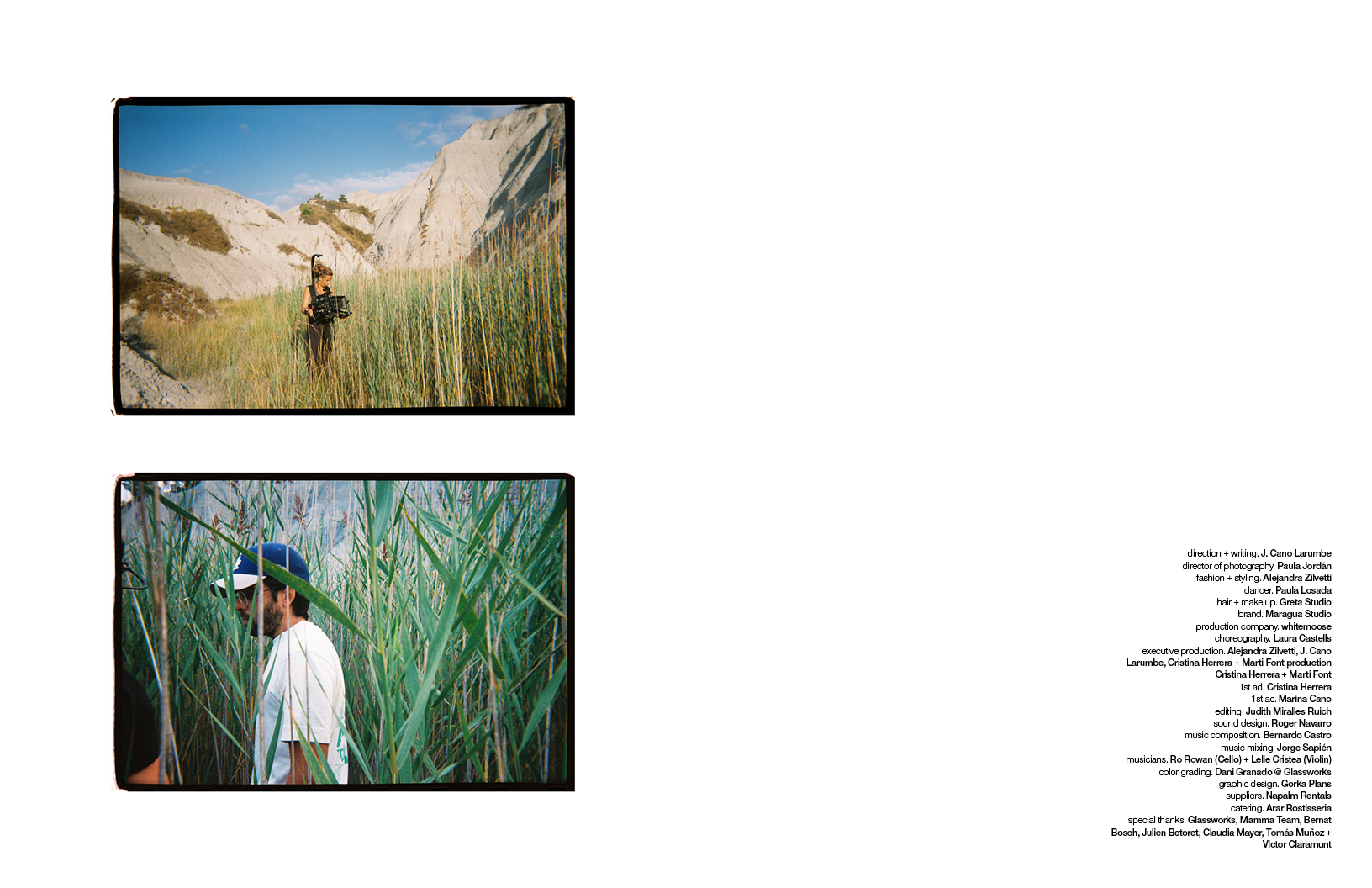
View the latest Maragua Studio collection now.
direction + writing. J. Cano Larumbe @ VIMEO
director of photography. Paula Jordán
fashion + styling. Alejandra Zilvetti
dancer. Paula Losada
hair + make up. Greta Studio
brand. Maragua Studio
production company. whitemoose
choreography. Laura Castells
executive production. Alejandra Zilvetti, J. Cano Larumbe, Cristina Herrera + Marti Font
production. Cristina Herrera + Marti Font
1st ad. Cristina Herrera
1st ac. Marina Cano
editing. Judith Miralles Ruich
sound design. Roger Navarro
music composition. Bernardo Castro
music mixing. Jorge Sapién
musicians. Ro Rowan (Cello) + Lelie Cristea (Violin)
color grading. Dani Granado @ Glassworks
graphic design. Gorka Plans
suppliers. Napalm Rentals
catering. Arar Rostisseria
special thanks. Glassworks, Mamma Team, Bernat, Bosch, Julien Betoret, Claudia Mayer, Tomás Muñoz + Victor Claramunt


Schön! Magazine is now available in print at Amazon,
as ebook download + on any mobile device












